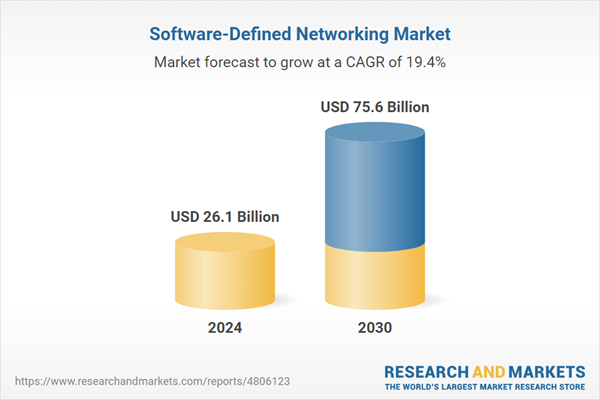The global market for Software-Defined Networking was valued at US$26.1 Billion in 2024 and is projected to reach US$75.6 Billion by 2030, growing at a CAGR of 19.4% from 2024 to 2030. This comprehensive report provides an in-depth analysis of market trends, drivers, and forecasts, helping you make informed business decisions. The report includes the most recent global tariff developments and how they impact the Software-Defined Networking market.
Segments: Component (Services, Software, Infrastructure); End-Use (Service Providers, Enterprises); Vertical (IT & Telecom, BFSI, Defense, Healthcare, Consumer Goods, Other Verticals).
Geographic Regions/Countries: World; USA; Canada; Japan; China; Europe; France; Germany; Italy; UK; Spain; Russia; Rest of Europe; Asia-Pacific; Australia; India; South Korea; Rest of Asia-Pacific; Latin America; Argentina; Brazil; Mexico; Rest of Latin America; Middle East; Iran; Israel; Saudi Arabia; UAE; Rest of Middle East; Africa.
The analysts continuously track trade developments worldwide, drawing insights from leading global economists and over 200 industry and policy institutions, including think tanks, trade organizations, and national economic advisory bodies. This intelligence is integrated into forecasting models to provide timely, data-driven analysis of emerging risks and opportunities.
Global Software-Defined Networking Market - Key Trends & Drivers Summarized
What Is Software-Defined Networking (SDN) and How Is It Transforming Networks?
Software-Defined Networking (SDN) is a revolutionary approach to network management that seeks to optimize the efficiency and agility of network operations. Unlike traditional networks, where the control plane is embedded within the hardware itself, SDN separates the network’s control logic from the underlying hardware. This abstraction allows network administrators to manage traffic from a centralized control point, making it easier to scale, secure, and manage networks dynamically. The flexibility of SDN is particularly beneficial in complex data center environments and enterprises where traffic loads are highly variable and network downtime can result in significant losses.How Are Advancements in SDN Technology Influencing IT Infrastructure?
Advancements in SDN technology are significantly influencing IT infrastructure by promoting greater automation and programmability in network configurations, maintenance, and management. SDN enables the deployment of automated and dynamic networking capabilities, supporting rapid changes to network configurations without the need for manual intervention. This is particularly advantageous in cloud computing and data center contexts, where virtualization technologies align well with SDN’s capabilities. Additionally, SDN facilitates more efficient load balancing, reduces operational costs by minimizing the reliance on physical hardware, and improves network visibility and control, which are critical for optimizing data traffic and preventing security breaches.What Are the Challenges and Opportunities in the SDN Market?
Despite its many benefits, the adoption of SDN technology faces several challenges. One of the primary concerns is the integration of SDN within existing network infrastructures without causing disruptions in service. Additionally, there is a significant learning curve associated with the deployment and management of SDN, requiring substantial training for IT staff. However, these challenges present opportunities for innovation and development within the SDN market. As cybersecurity threats become more sophisticated, the intrinsic security features of SDN, like improved network visibility and centralized control, provide substantial opportunities for growth. Moreover, the ongoing push towards digital transformation in various industries represents a pivotal driver for the expansion of SDN solutions, as organizations seek more efficient and flexible networking solutions to support their IT operations.What Drives the Growth in the Software-Defined Networking Market?
The growth in the software-defined networking market is driven by several factors, including the increasing demand for cloud services, the proliferation of data-intensive applications, and the need for improved network management and efficiency. As more organizations migrate to the cloud and deploy IoT technologies, the flexibility and scalability offered by SDN become critical to managing the complex and dynamic traffic patterns these technologies generate. Additionally, the shift towards virtualized network services, where SDN can provide significant operational efficiencies and cost reductions, fuels further adoption. Consumer behavior that prioritizes agility, security, and cost-effectiveness in network services also promotes SDN adoption.Report Scope
The report analyzes the Software-Defined Networking market, presented in terms of units. The analysis covers the key segments and geographic regions outlined below.Segments: Component (Services, Software, Infrastructure); End-Use (Service Providers, Enterprises); Vertical (IT & Telecom, BFSI, Defense, Healthcare, Consumer Goods, Other Verticals).
Geographic Regions/Countries: World; USA; Canada; Japan; China; Europe; France; Germany; Italy; UK; Spain; Russia; Rest of Europe; Asia-Pacific; Australia; India; South Korea; Rest of Asia-Pacific; Latin America; Argentina; Brazil; Mexico; Rest of Latin America; Middle East; Iran; Israel; Saudi Arabia; UAE; Rest of Middle East; Africa.
Key Insights:
- Market Growth: Understand the significant growth trajectory of the Services segment, which is expected to reach US$30.9 Billion by 2030 with a CAGR of a 19.0%. The Software segment is also set to grow at 19.2% CAGR over the analysis period.
- Regional Analysis: Gain insights into the U.S. market, valued at $8.0 Billion in 2024, and China, forecasted to grow at an impressive 26.0% CAGR to reach $16.0 Billion by 2030. Discover growth trends in other key regions, including Japan, Canada, Germany, and the Asia-Pacific.
Why You Should Buy This Report:
- Detailed Market Analysis: Access a thorough analysis of the Global Software-Defined Networking Market, covering all major geographic regions and market segments.
- Competitive Insights: Get an overview of the competitive landscape, including the market presence of major players across different geographies.
- Future Trends and Drivers: Understand the key trends and drivers shaping the future of the Global Software-Defined Networking Market.
- Actionable Insights: Benefit from actionable insights that can help you identify new revenue opportunities and make strategic business decisions.
Key Questions Answered:
- How is the Global Software-Defined Networking Market expected to evolve by 2030?
- What are the main drivers and restraints affecting the market?
- Which market segments will grow the most over the forecast period?
- How will market shares for different regions and segments change by 2030?
- Who are the leading players in the market, and what are their prospects?
Report Features:
- Comprehensive Market Data: Independent analysis of annual sales and market forecasts in US$ Million from 2024 to 2030.
- In-Depth Regional Analysis: Detailed insights into key markets, including the U.S., China, Japan, Canada, Europe, Asia-Pacific, Latin America, Middle East, and Africa.
- Company Profiles: Coverage of players such as Cisco Systems, Inc., Broadcom Inc., Avaya, Inc., Ciena Corporation, CenturyLink, Inc. and more.
- Complimentary Updates: Receive free report updates for one year to keep you informed of the latest market developments.
Some of the 88 companies featured in this Software-Defined Networking market report include:
- Cisco Systems, Inc.
- Broadcom Inc.
- Avaya, Inc.
- Ciena Corporation
- CenturyLink, Inc.
- AudioCodes Ltd.
- AT&T Enterprise Business
- Arista Networks, Inc.
- Aryaka Networks, Inc.
- Capgemini Engineering (Altran Technologies)
- Affirmed Networks
- Calsoft Inc.
- Certes Networks, Inc.
- ALTEN Calsoft Labs
- Adaptiv Networks
Tariff Impact Analysis: Key Insights for 2025
Global tariff negotiations across 180+ countries are reshaping supply chains, costs, and competitiveness. This report reflects the latest developments as of April 2025 and incorporates forward-looking insights into the market outlook.The analysts continuously track trade developments worldwide, drawing insights from leading global economists and over 200 industry and policy institutions, including think tanks, trade organizations, and national economic advisory bodies. This intelligence is integrated into forecasting models to provide timely, data-driven analysis of emerging risks and opportunities.
What’s Included in This Edition:
- Tariff-adjusted market forecasts by region and segment
- Analysis of cost and supply chain implications by sourcing and trade exposure
- Strategic insights into geographic shifts
Buyers receive a free July 2025 update with:
- Finalized tariff impacts and new trade agreement effects
- Updated projections reflecting global sourcing and cost shifts
- Expanded country-specific coverage across the industry
Table of Contents
I. METHODOLOGYII. EXECUTIVE SUMMARYSELECT BRANDS2. FOCUS ON SELECT PLAYERSIII. MARKET ANALYSISCANADAITALYSPAINRUSSIAREST OF EUROPESOUTH KOREAREST OF ASIA-PACIFICARGENTINABRAZILMEXICOREST OF LATIN AMERICAIRANISRAELSAUDI ARABIAUNITED ARAB EMIRATESREST OF MIDDLE EASTIV. COMPETITION
1. MARKET OVERVIEW
3. MARKET TRENDS & DRIVERS
4. GLOBAL MARKET PERSPECTIVE
UNITED STATES
JAPAN
CHINA
EUROPE
FRANCE
GERMANY
UNITED KINGDOM
ASIA-PACIFIC
AUSTRALIA
INDIA
LATIN AMERICA
MIDDLE EAST
AFRICA
Companies Mentioned (Partial List)
A selection of companies mentioned in this report includes, but is not limited to:
- Cisco Systems, Inc.
- Broadcom Inc.
- Avaya, Inc.
- Ciena Corporation
- CenturyLink, Inc.
- AudioCodes Ltd.
- AT&T Enterprise Business
- Arista Networks, Inc.
- Aryaka Networks, Inc.
- Capgemini Engineering (Altran Technologies)
- Affirmed Networks
- Calsoft Inc.
- Certes Networks, Inc.
- ALTEN Calsoft Labs
- Adaptiv Networks
Table Information
| Report Attribute | Details |
|---|---|
| No. of Pages | 829 |
| Published | April 2025 |
| Forecast Period | 2024 - 2030 |
| Estimated Market Value ( USD | $ 26.1 Billion |
| Forecasted Market Value ( USD | $ 75.6 Billion |
| Compound Annual Growth Rate | 19.4% |
| Regions Covered | Global |









